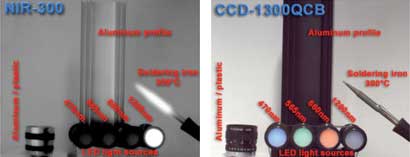There are many potential uses in industry for imaging in the near-infrared (NIR) region, but until recently, InGaAs sensors with high spatial resolution were found only in military and astronomy applications because of their high cost.
Now, Raf Slotwinski, business development manager of Alrad Instruments Ltd. in Newbury, UK, has told me about some new cameras with VGA resolution that are coming on the market at prices that will begin to open up industrial uses.
Because light in the NIR passes through paint – and some inks and glues – it can measure the level of liquids in semi-opaque bottles and can detect surface defects beneath the paint of cars. It also can reveal original drawings and paintwork in the underlayers of Old Master paintings, useful in art restoration.
In the semiconductor industry, NIR cameras inspect wafers and dies because silicon is transparent at these wavelengths. The microscopist can examine structures on both sides of a wafer by focusing first on one side and then on the other.
In telecommunications, an NIR camera grabs dynamic images of routers, switches and optical fibre ends to reveal the presence and behaviour of laser light within the fibres. In traffic management, infrared images can show the number of real (as opposed to mannequins) people present in cars driving in multiple-occupancy lanes.

Two cameras from VDS Vosskühler GmbH capture the same scene. The visible-region camera, CCD-1300QCB, sees all the LED sources but is not very sensitive to the one at 1200 nm. The NIR-300, however, with its VGA InGaAS sensor, picks out the LED source and also the hot tip of the soldering iron.
The NIR region covers wavelengths from 0.75 to 3 μm, and InGaAs has a spectral response from 0.9 to 1.7 μm. The material is very sensitive and has good linearity. Its high damage threshold allows direct beam illumination of the sensor for laser beam profiling. VDS Vosskühler GmbH of Osnabrück, Germany, recently introduced the NIR-600P, a cooled camera with industry-friendly C-mount lenses and a Camera Link or Gigabit Ethernet interface. It has 640 × 512 pixels and 14-bit grey scale and operates at 30 fps. It also has a trigger mode and can grab single images on demand. Besides laser beam profiling, it detects hot objects and sorts various types of plastic.
More affordable lower resolution 1/4 VGA models also are available from VDS, with both Camera Link and Gigabit Ethernet interfaces and in cooled or uncooled versions. The XEVA-FPA-640 from XenICs NV of Louvain, Belgium, is a compact camera head with integrated temperature control and low-noise circuitry, and a USB interface for computer control. The same company makes the XS-FPA-1.7-320 camera, which uses an uncooled InGaAs array. Introduced in 2006, this camera’s sensor is only 1/4 VGA, but it is well suited to industrial applications because of its compact size, C-mount lens, USB 2 control and data interface, and Windows-based software.
Silicon sensors respond to wavelengths up to 1100 nm and are much cheaper than InGaAs, so vision integrators sometimes use CCD cameras with filters to block the ambient visible light as a low-cost way to access part of the NIR region. VDS Vosskühler’s CCD1020, for example, provides megapixel resolution with 12-bit output and high sensitivity in the NIR.
Whichever approach a customer uses, NIR machine vision looks set to increase its impact on industrial inspection activities in 2009.